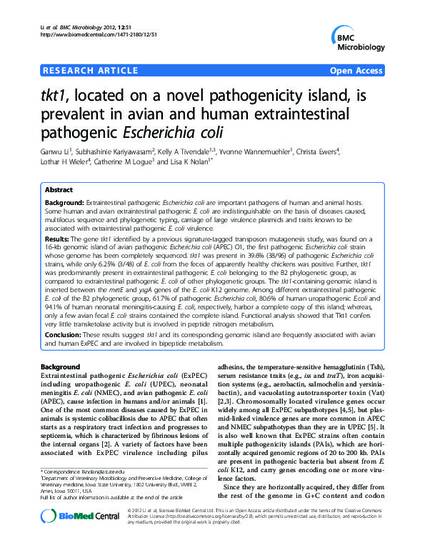
Background: Extraintestinal pathogenic Escherichia coli are important pathogens of human and animal hosts. Some human and avian extraintestinal pathogenic E. coli are indistinguishable on the basis of diseases caused, multilocus sequence and phylogenetic typing, carriage of large virulence plasmids and traits known to be associated with extraintestinal pathogenic E. coli virulence.
Results: The gene tkt1 identified by a previous signature-tagged transposon mutagenesis study, was found on a 16-kb genomic island of avian pathogenic Escherichia coli (APEC) O1, the first pathogenic Escherichia coli strain whose genome has been completely sequenced. tkt1 was present in 39.6% (38/96) of pathogenic Escherichia coli strains, while only 6.25% (3/48) of E. coli from the feces of apparently healthy chickens was positive. Further, tkt1 was predominantly present in extraintestinal pathogenic E. coli belonging to the B2 phylogenetic group, as compared to extraintestinal pathogenic E. coli of other phylogenetic groups. The tkt1-containing genomic island is inserted between the metE and ysgA genes of the E. coli K12 genome. Among different extraintestinal pathogenic E. coli of the B2 phylogenetic group, 61.7% of pathogenic Escherichia coli, 80.6% of human uropathogenic E.coli and 94.1% of human neonatal meningitis-causing E. coli, respectively, harbor a complete copy of this island; whereas, only a few avian fecal E. coli strains contained the complete island. Functional analysis showed that Tkt1 confers very little transketolase activity but is involved in peptide nitrogen metabolism.
Conclusion: These results suggest tkt1 and its corresponding genomic island are frequently associated with avian and human ExPEC and are involved in bipeptide metabolism.
Available at: http://works.bepress.com/lisa_nolan/21/

This article is from BMC Microbiology 12 (2012): 51, doi:10.1186/1471-2180-12-51.